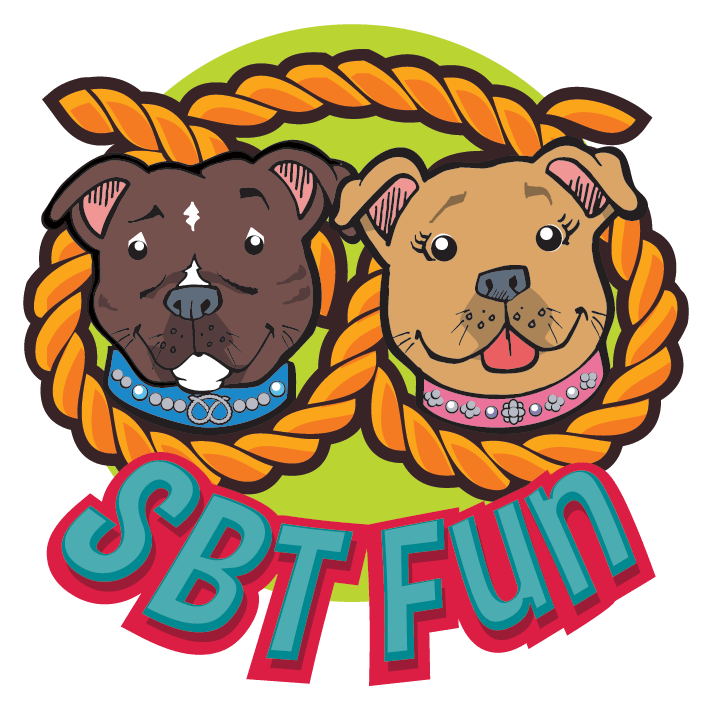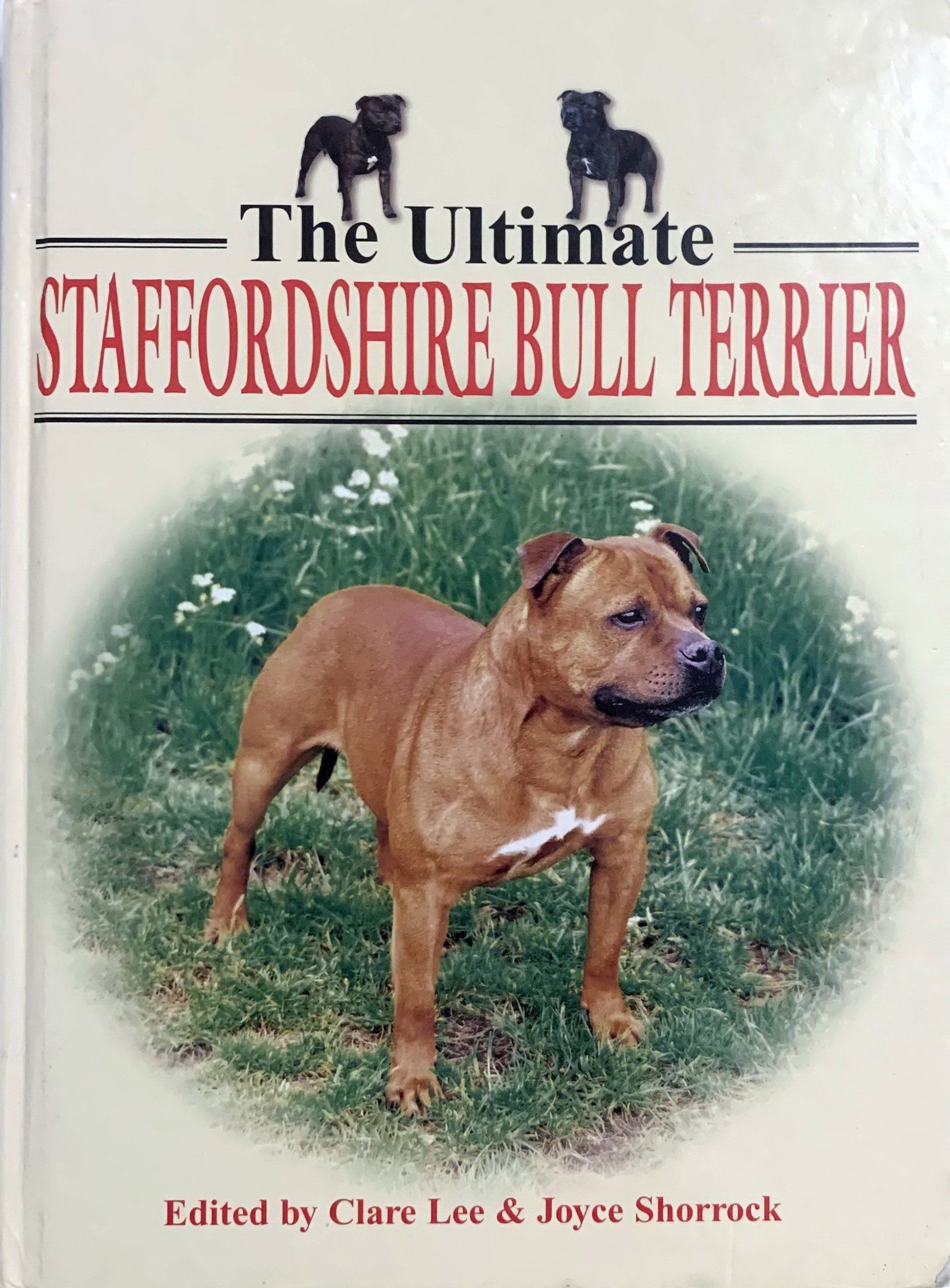First Published: 2003
Hardcover 256 pages (31 January 2003)
Publisher: Ringpress Books Ltd
ISBN-10: 1860542816
ISBN-13: 978-1860542817
Product Dimensions: 20.3cm x 27.3 cm
Book Weight: 1116g approx
Book Description:
The Staffordshire Bull Terrier is among the most popular of pet dogs in the UK and the editors have recruited a host of specialists to write the definitive book on the breed. The book includes expert advice about choosing a healthy puppy and raising him to be a loving companion. There is emphasis on the importance of training and socialisation with contributions from top trainers and handlers.
There is also an invaluable chapter on healthcare focusing on preventative care and breed-specific conditions. There is a book for both the novice and
experienced.
The Staffordshire Bull Terrier is one of the great characters of the dog world. Lively, loyal, and affectionate, the Stafford is best known for being a great people-lover, who gives his heart to his family – and to everyone he meets.
Originally bred to bait bulls and for ratting, ‘sports’ which lost favour with the aristocracy, the Stafford was taken into the homes of the less privileged, where he became a much-loved family pet. Here, he learnt his great ‘people skills’, and has maintained his position as a popular family pet ever since.
In The Ultimate Staffordshire Bull Terrier, editors Clare Lee and Joyce Shorrock have recruited a star-studded cast of specialists to write the definitive book on the breed.
Starting with in-depth research into the origins and development of the breed, the experts write about the choosing, raising, socialising and training of a
Stafford puppy, with detailed information on everything you need to know to get you through puppyhood.
Caring for an adult dog is examined, with a chapter devoted to Stafford nutrition. There is a wealth of information on the health of the Stafford, written
by veterinary specialists in the breed, with details on general care through to breed-specific problems that the Stafford may experience.
Although the Stafford is not well known for his training skills, many have achieved top honours in Competitive Obedience, Agility and Working Trials, and these sports are covering in a chapter on training, which also covers basic puppy obedience.
The Breed Standard is analysed in full, with helpful line-drawings to explain what is required in the show ring. Another chapter, on showing, describes all aspects of exhibiting this popular dog.
All-time great Staffords are covered, with information on the influential dogs from the breed’s early history through to the top-winning Staffords of today, and there are also chapters on mating, breeding, whelping and rearing.
Finally, a top canine art historian describes how the breed has been celebrated in all art forms throughout its history.
Illustrated throughout with top-class colour photography and line-drawings, The Ultimate Staffordshire Bull Terrier is essential reading for all enthusiasts of this unique breed.
Front cover: Ch. Bowtmans Red October; owned and bred by Colin and Carol Powell.
Back cover: English school oil on canvas, c1840, reproduced courtesy of Iona Antiques London.
CONTENTS:
Chapter One: INTRODUCTING THE STAFFORD
History of the breed
Bulldog beginnings
Mastiff might
Taking the bait
Size reduction
Great white debate
Terrier traits
Birth of the Bull Terrier
Colour controversy
Growing support
The Stafford emerges
Road to recognition
First registrations
Champion times
Club matters
Important directions
The breed today
Chapter Two: THE STAFFORD IN ART
Stafford origins
The medieval period
Staffords in the 18th and 19th centuries (Mezzotint by William Say)
Aristocratic popularity (Wasp, Child and Billy)
Stafford development
Rise of the fighting dog
Henry Alken and son
Growth of rat pits
Literature
Sculptures
Pottery (Royal Doulton and Beswick, Other contemporary artists)
Dog collars
Chapter Three: THE STAFFORD PUPPY
Inheriting a history
Finding a puppy
Reputable breeders
Patience is a virtue
Meeting the breeder
Male or Female
Colour choice
Signs of good health
Clues to temperament
Numbers game
Pedigree Papers
The show puppy (Check points; Spotting potential; Head; Mouth; Body; Physical development)
Preparing for the puppy (Sleeping arrangements; Bowls; Collar and Lead; Crate; Toys; Safety measures; Finding a vet)
Collecting your pup
Chapter Four: THE RIGHT START
House rules
Home at last
House-training
First night
Cosy crates (Crate-training)
Peace and quiet
Family introductions (Children, Feline friends; Other dogs)
Hierarchy
Avoiding Conflict
Socialisation
Welcome visitors
Dog-friendly
Socialisation classes
Early training (“No”)
Exercise (Adult exercise)
Car travel
Feeding your pup
Coat care
Dental care
Holiday season
Rescued dogs
Vet check (Worming, Identification, Neutering, Pet insurance)
Chapter Five: TRAINING YOUR STAFFORD
Basic Obedience training (Watch; Collar and lead; Walking to heel; Sit; Down; Come; Stay; Nosework; Basic road training)
Responsible owner
Agility (Faults; Getting started; Fun at home)
Working Trials (Agility section; Control section; Nosework section; Stay section; Tracking section)
Obedience (Finding a training club)
Good Citizen Scheme
Therapy Dogs
Clever Staffords
Behaviour problems (Chewing, Barking, Pulling on the lead; Aggression to other dogs; Jumping Up)
Chapter Six: DIET AND NUTRITION
Essential nutrition
Energy
Varying requirements
Obesity
Fat
Protein
Choosing a diet
Feeding for growth
Hip dysplasia
Dietary deficiencies
Pregnancy and lactation
Maintenance and old age
Food labelling (Complete versus complementary; Dry matter; Cost)
Home-made diets
Summary
Chapter Seven: THE BREED STANDARD
Setting the Standard
The original 1935 Standard
1948 Standard
The third Standard
1987 Breed Standard (General Appearance; Characteristics; Temperament; Head and Skull. Eyes; Ears; Mouth; Neck; Forequarters; Body; Hindquarters; Feet; Tail; Gait/movement. Coat; Colour; Size)
Beilby’s suggested Standard
Chapter Eight: ALL-TIME GREATS
1930s and 1940s
1950s and 1960s
Early 1970s
Late 1970s and early 1980s
Late 1980s onwards
A rosy future
Chapter Nine: BREEDING STAFFORDS
Matching the Standard (Pedigrees)
Principals of heredity (Dominant and recessive traits)
Breeding for colour (White; Black; Fawn; Brindle; Blue; Red)
Establishing a breeding programme (Inbreeding; Linebreeding; Outcrossing; The pet market)
Breeding stock (Choosing a brood bitch)
Choosing a stud dog (Fertility; Breeding cycles)
Owning a brood bitch (Practical precautions; Artificial insemination)
Owning a stud dog (Acquiring the puppy; The young, untried stud dog; Legal and financial arrangements; Stud dog health; Matings; after the mating)
The litter
Chapter Ten: MATING, WHELPING AND REARING
Points to consider
The breeding pair (Finding a stud dog; The bitch’s age; Health considerations)
Choosing the right time
Mating (Introductions; Mating; Mating problems; After mating)
Pregnancy (Gestation period; The pregnant bitch)
Whelping (Whelping box; Equipment; Stage of labour; Caring for the newborns; Birthing complications; Aftercare)
The lactating bitch
Puppies (Feeding; Puppy development; Parasite Control; Weaning; Play; Finding new homes)
Chapter Eleven: SHOWING YOUR STAFFORD
Types of show (General notes on classes; UK shows; Shows in other countries)
Making a Champion (America; Australia; Britain; Eire; Germany; New Zealand; South Africa.
Champions in Europe; International Champions)
Getting started (Finding shows)
Ring training (Standing and stacking; Examining; Moving)
Grooming and appearance (Feeding and exercise; Grooming; Accessories)
Show preparations (Clothes; Equipment)
The day of the show (In the ring; Winning and losing)
Chapter Twelve: HEALTH CARE
Regular checks (Skin; Eyes; Ears; Mouth; Genitalia; Feet)
Choosing a veterinarian
Insurance
Vaccinations (Standard vaccinations; Other vaccinations; Socialisation classes)
Identification
Nutrition
Parasite control (Internal parasites; External parasites)
Neutering (Castration; Spaying)
Common ailments (Vomiting and diarrhoea; Constipation; Heat stroke; Wasp stings; Road traffic accidents)
Chapter Thirteen: BREED-RELATED CONDITIONS
Skin diseases (Atopic dermatitis; Demodicosis)
Orthopaedic diseases (Luxating patella; Cruciate disease; Hip dysplasia; Panoesteitis; Osteochondrosis)
Eye diseases (Hereditary diseases; Non-hereditary diseases)
Reproductive problems (Female; Male)
Miscellaneous complaints (Food allergies; Overlong soft palate)
ABOUT THE AUTHORS:
Clare Lee
Clare Lee was brought up with Staffordshire Bull Terriers. Her father, Mr Cairns, was the founder of the famous Constones kennels, with whom Clare and her husband went into partnership in the 1960s.
Since the sixties, nine UK Staffords and numerous other winners have carried the Constones prefix, most famous of all being Ch. Constones Yer Man, who broke the then breed record and retired after winning his twentieth CC and Best of Breed at the Centenary Crufts Dog Show. He was also the sire of 11 Champions.
Clare has been awarding Challenge Certificates since 1973 and has judged throughout the UK, including at Crufts in 1985, the fiftieth anniversary of the recognition of the breed, Clare has also judged throughout Europe (Austria, Belgium, Eire, Finland, Germany, Holland, Spain and Sweden) as well as around the rest of the world (Australia, Canada, South Africa and the United States)
Clare regularly gives seminars on the breed and is the author of Pet Owner’s Guide to the Staffordshire Bull Terrier, published by Ringpress Books.
Joyce Shorrock
Joyce Shorrock established her Eastaff kennel more than 50 years ago. Within two years, in 1954, she produced her first Champion – Constones Eastaff This’ll Do. Undoubtedly, the most famous Champion she has produced is Ch. Eastaff Danom, born in 1955. Danom was a pillar of the breed, winning no fewer than 11 Challenge Certificates and siring a further 11 Champions. In total, a dozen CC winners carry the Eastaff prefix.
Joyce was the secretary for the East Anglian Staffordshire Bull Terrier Club for more than 27 years before she retired from the post. Today, she is a well-respected Championship show judge, who judged at Crufts in the Millennium year. In addition, she has adjudicated in Eire, Finland, Germany, Australia, New Zealand, South Africa, and the US.

